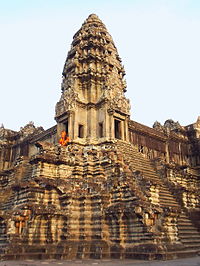Varchas
"The Mirrored City, where Light was always the Law..."[1]
"They worship the sun in Varchas, and have banished darkness from the city."[2]
"The city is a beacon against the tree-hushed, sprawling darkness of the Elder Continent. In the far distance a vast mountain glimmers."[3]
Varchas is a city of light and mirrors on the Elder Continent.
City of Glass
The inhabitants of Varchas believe that darkness does something similar to stealing one's soul, in that it "joins" those exposed to it to the name-stealing god Taamas[citation needed]. As a result, the Varchasi worship Mihir, the god of light, and they only let people from darker parts of the Neath stay in Varchas for one day at a time.[4] The priests and priestesses of Mihir radiate a large amount of heat, and they believe the reason they fell into the Neath is because Mihir lost them. They hope that the massive amount of light that they produce will help Mihir find them again.[5]

Varchas is constantly illuminated by candles and mirrors. The Varchasi are well aware of the presence of the Fingerkings, who seek to escape from the city's many mirrors. As such, it is advised that one tries not to dream, touch the mirrors[6], eat meat[7], or tell fictional or exaggerated stories[8]. For sleeping, they peddle sigil-marked snakeskin charms that either keep the Fingerkings away or prevent the dreamer from remembering them after an encounter.[9]
When the Fingerkings do possess an individual, the poor soul is simply locked away from mirrors. They are given food and water to survive, and even kept in the light, despite the costs.[10]
Strangely enough, mushrooms are surprisingly populous here, growing where the mirrors can't reach. Zailors don't like it here, they share horror stories about this place that are almost always without bearing.[3]
Origins and Real-World Parallels

|
Beyond this point lie major spoilers for Fallen London, Sunless Sea, Sunless Skies, or Mask of the Rose. This may include endgame or major Fate-locked spoilers. Proceed at your own risk. You can find out more about our spoiler policy here. |
Varchas is an anomaly, even for the Neath. The culture of Varchas is oddly out of place; its name translates to radiance in Hindi. Their god's name Mihir is a slight variation of Mihira, an Indo-Iranian version of the Hindu sun god Mithra. Even the title of Taamas is based on Tamas, a Hindu term for ignorance and darkness. Why is there so much Hindu culture in this city?

Well, five towers make up the heart of the city; also note the design of the city towers in the images above. This is possibly Khmer style, an architectural style very common in Cambodia around the 8th-15th centuries. Why is this important? Well, there's only one place where Hindu religion, Sanskrit terminology, layout, and architecture come into one place: Angkor Wat, the ancient temple city in modern-day Cambodia.

This holds a vast array of questions and problems in the Neathy Universe. In the lore of the series it is known that the Bazaar has brought down only five cities out of the supposed 7 it said it will bring. What could this mean for the history of the Neath? In exploring Varchas it should be noted that the people make no reference to the Bazaar or the Masters in any way. According to their legends, it was Mihir that brought the city down - the Sun. This would explain its proximity to the Mountain of Light, who just happens to be the daughter of the Bazaar and... the Sun. So this is not one of the seven fallen cities. The Sun is trying to keep his lover and daughter company. How adorable.
As to why it might have something to do with the history of the Khmer Empire: while the temple itself was originally dedicated to the Hindu gods, it was converted into a Buddhist temple in the 12th century. Perhaps this spited the Sun, and as punishment he brought the city down to the Neath. This could simultaneously explain how such a city got here while keeping the truth that London and the other 4 cities were brought down by the Bazaar. This also possibly wouldn't be the first time a city was lost without the Master's intervention, as Irem might have been lost in a similar way (possibly through Parabola).
References
- ↑ Port description, Sunless Sea
- ↑ Varchas: The Mirrored City, Sunless Sea
- ↑ 3.0 3.1 The Burning White Light of Varchas, Sunless Sea
- ↑ Returning to Varchas, Sunless Sea
- ↑ Listen to the Mantras, Sunless Sea "Mihir looked away away from us, and Varchas fell. Now we light our city like a beacon, so Mihir may find us once more."
- ↑ Ask about the city's customs, Sunless Sea
- ↑ The Kitchens, Sunless Sea
- ↑ At the Mansion of the Jewel-Turbaned Youth, Sunless Sea
- ↑ Dreams of Smoke, Sunless Sea
- ↑ The Mirrorless Room, Sunless Sea